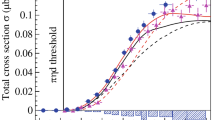Abstract.
Elastic and proton-dissociative \(\rho^0\) photoproduction (\(\gamma p \rightarrow \rho^0 p\), \(\gamma p \rightarrow \rho^0 N\), respectively, with \(\rho^0 \rightarrow \pi^+\pi^-\)) has been studied in \(ep\) interactions at HERA for photon-proton centre-of-mass energies in the range \(50 < W < 100\) GeV and for \(|t| < 0.5\) GeV\(^2\), where \(t\) is the square of the four-momentum transfer at the proton vertex; the results on the proton-dissociative reaction are presented for masses of the dissociated proton system in the range \(M_N^2 < 0.1 W^2\). For the elastic process, the \(\pi^+\pi^-\) invariant mass spectrum has been investigated as a function of \(t\). As in fixed target experiments, the \(\rho^0\) resonance shape is asymmetric; this asymmetry decreases with increasing \(|t|\), as expected in models in which the asymmetry is ascribed to the interference of resonant and non-resonant \(\pi^+\pi^-\) production. The cross section has been studied as a function of \(W\); a fit to the resonant part with the form \(W^a\) gives \(a=0.16\pm 0.06 \mbox{(stat.)} ^{+0.11}_{-0.15} \mbox{(syst.)}\). The resonant part of the \(\gamma p \rightarrow \pi^+\pi^- p\) cross section is \(11.2\pm 0.1 \mbox{(stat.)} ^{+1.1}_{-1.2} \mbox{(syst.)}\) \(\mu\)b at \(\langle W\rangle=71.7\) GeV. The \(t\) dependence of the cross section can be described by a function of the type \(A_{\rho} \exp{(-b_{\rho} |t| + c_{\rho} t^2)}\) with \(b_{\rho}= 10.9 \pm 0.3\) (stat.) \(^{+1.0}_{-0.5}\) (syst.) GeV\(^{-2}\) and \(c_{\rho}= 2.7 \pm 0.9\) (stat.) \(^{+1.9}_{-1.7}\) (syst.) GeV\(^{-4}\). The \(t\) dependence has also been studied as a function of \(W\) and a value of the slope of the pomeron trajectory \(\alpha_{\mathbb{P}}^{\prime}= 0.23 \pm 0.15 \mbox{(stat.)} ^{+0.10}_{-0.07} \mbox{(syst.)}\) GeV\(^{-2}\) has been deduced. The \(\rho^0\) spin density matrix elements \(r^{04}_{00}\), \(r^{04}_{1-1}\) and \({\frak R}{e[r^{04}_{10}]}\) have been measured and found to be consistent with expectations based on \(s\)-channel helicity conservation. For proton-dissociative \(\pi^+\pi^-\) photoproduction in the \(\rho^0\) mass range, the distributions of the two-pion invariant mass, \(W\) and the polar and azimuthal angles of the pions in the helicity frame are the same within errors as those for the elastic process. The \(t\) distribution has been fitted to an exponential function with a slope parameter \(5.8 \pm 0.3 \mbox{(stat.)} \pm 0.5 \mbox{(syst.)}\) GeV\(^{-2}\). The ratio of the elastic to proton-dissociative \(\rho^0\) photoproduction cross section is \(2.0 \pm 0.2 \mbox{(stat.)} \pm 0.7 \mbox{(syst.)}\).
Similar content being viewed by others
Author information
Authors and Affiliations
Consortia
Additional information
Received: 3 December 1997 / Online publication: February 26, 1998
Rights and permissions
About this article
Cite this article
The ZEUS Collaboration., Breitweg et al., J. Elastic and proton-dissociative \(\rho^0\) photoproduction at HERA. Eur. Phys. J. C 2, 247–267 (1998). https://doi.org/10.1007/s100529800834
Issue Date:
DOI: https://doi.org/10.1007/s100529800834



